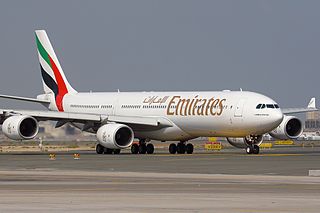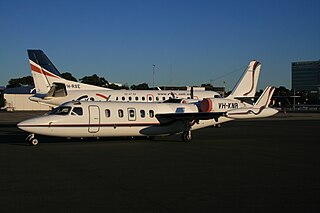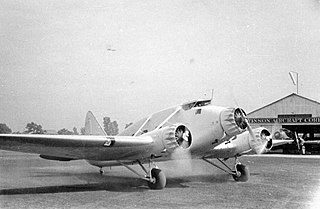
Moorabbin Airport is a mostly general aviation airport for light aircraft located in between the southern Melbourne suburbs of Heatherton, Cheltenham, Dingley Village and Mentone. It also receives commercial airline service. The airport grounds are treated as their own suburb, and share the postcode 3194 with the neighbouring suburb of Mentone. With a total of 274,082 aircraft movements, Moorabbin Airport was the second busiest airport in Australia for the calendar year 2011.

Qantas 1 was a Qantas passenger flight between Sydney and London. On 23 September 1999, the aircraft operating as Flight 1 had departed from Sydney that day, and was involved in a runway overrun accident at Don Mueang International Airport in Bangkok as it was landing for a stopover.

Connellan Airways was an airline headquartered in Alice Springs, Australia. It operated scheduled flights as well other air transport services throughout the Northern Territory from 1939 to 1980.

Garuda Indonesia Flight 200(GA200/GIA 200) was a scheduled domestic passenger flight of a Boeing 737-400 operated by Garuda Indonesia between Jakarta and Yogyakarta, Indonesia. The aircraft overran the runway, crashed into a rice field and burst into flames while landing at Adisucipto International Airport on 7 March 2007. Twenty passengers and one flight attendant were killed. Both pilots survived, and were fired shortly after the accident occurred. It was the fifth hull-loss of a Boeing 737 in Indonesia within less than six months and was the most recent accident with fatalities involving the airline.

Emirates Flight 407 was a scheduled international passenger flight operated by Emirates from Auckland to Dubai with a stopover in Melbourne, operated by an Airbus A340-500 aircraft. On 20 March 2009, the flight failed to take off properly at Melbourne Airport, hitting several structures at the end of the runway before climbing and then returning to the airport for a safe landing. Although no fatalities or injuries resulted, damage to the aircraft was severe enough for the event to be classified by Australian Transport Safety Bureau as an "accident". It was subsequently determined that a data-entry error resulted in insufficient engine thrust during take off. It has been described "as close as we have ever come to a major aviation catastrophe in Australia" by aviation officials.

The 2009 Pel-Air Westwind ditching or Norfolk Island ditching was an aircraft accident on 18 November 2009 near Norfolk Island, Australia. A Westwind II jet operated by Pel-Air was conducting an air ambulance flight for CareFlight International when it was forced to ditch after being unable to land in bad weather and not having sufficient fuel to divert to an alternate destination.

Qantas Flight 32 was a regularly scheduled passenger flight from London to Sydney via Singapore. On 4 November 2010, the aircraft operating the route, an Airbus A380, suffered an uncontained failure in one of its four Rolls-Royce Trent 900 engines. The failure occurred over the Riau Islands, Indonesia, four minutes after takeoff from Singapore Changi Airport. After holding for almost two hours to assess the situation, the aircraft made a successful emergency landing at Changi. No injuries occurred to the passengers, crew, or people on the ground, despite debris from the aircraft falling onto houses in Batam.

Ansett-ANA Flight 149 crashed near Winton in Queensland, Australia on 22 September 1966, killing all on board. The Vickers Viscount aircraft departed from Mount Isa, Queensland, Australia for a 73-minute flight to Longreach. Forty-four minutes after takeoff a fire started in one of the engines. The crew were unable to extinguish the fire or feather the propeller so made an emergency descent with the intention of landing at Winton, a small town along the route. The fire spread to the fuel tank and weakened the wing structure so that a large part of the left wing broke away and the aircraft crashed. All twenty-four occupants were killed. The accident remains the fifth-worst in Australia's civil aviation history.

On the evening of 30 November 1961, Ansett-ANA Flight 325, a service from Sydney to Canberra, Australia, operated by a Vickers Viscount 720, broke up in mid-air and crashed shortly after takeoff, when it encountered a severe thunderstorm. All 15 people on board were killed.

On Sunday 10 March 1946 a Douglas DC-3 aircraft departed from Hobart, Tasmania for a flight to Melbourne. The aircraft crashed into the sea with both engines operating less than 2 minutes after takeoff. All twenty-five people on board the aircraft died. It was Australia's worst civil aviation accident at the time.

On 10 March 1949 a Lockheed Lodestar aircraft became airborne at Coolangatta, Queensland, Australia for a flight to Brisbane. Before reaching a height of 300 feet (90 m) it suddenly pitched nose-up, stalled and crashed onto its belly beyond the end of the airstrip.

On 31 January 1945 a Stinson Model A aircraft departed from Melbourne for a flight of 127 nautical miles (235 km) to Kerang, Victoria—the first leg of an Australian National Airways regular scheduled service to Broken Hill, New South Wales. It crashed 50 nmi (93 km) from Melbourne. All ten occupants were killed in the accident. The aircraft was one of four Stinsons imported in 1936 by Airlines of Australia (AoA). Three had now crashed with the loss of 17 lives, and the fourth would not be permitted to fly again.

Caloundra Airport is a public general aviation airport located in Caloundra West serving the Sunshine Coast in the Australian state of Queensland. The airport is located on a 130 ha site, of which 74 ha is occupied by the current facilities. Further growth and expansion of the airport is limited by urban encroachment as much of the surrounding land has been developed into residential estates. The airport has been managed by Sunshine Coast Airports, a business unit of the Sunshine Coast Regional Council which is also responsible for the operations of the Sunshine Coast Airport at Maroochydore since 2008.

Whyalla Airlines Flight 904 was a scheduled commuter flight, operated by a Piper PA-31 Navajo which crashed while attempting to ditch in the Spencer Gulf, South Australia after suffering failures of both engines on the evening of 31 May 2000. All 8 people on board the aircraft were killed as a result of the accident. The findings of a subsequent investigation by the Australian Transport Safety Bureau highlighting the airline's operating procedures as a key factor leading to the accident were later overturned after they were contradicted by evidence presented at a coronial inquiry into the deaths of those on board the flight. The safety implications arising from the accident led to a recall by engine manufacturer Textron Lycoming which saw close to 1000 aircraft grounded worldwide while defects were rectified at an estimated cost of $A66 million. Australia's aviation regulator, the Civil Aviation Safety Authority also mandated lifejackets be carried on all aircraft operating over water after the crash.
Advance Airlines was an Australian airline that operated from 1974 to 1981. It was run by former bush pilot Bryan Greenberger.
Aviair Pty Ltd, previously known as Slingair Heliwork, is an airline and air charter company based in Kununurra, Western Australia. It is a wholly owned subsidiary of HM Consolidated Pty Ltd. It operates air charter services and regular passenger services. Its main bases are Kununurra Airport, Broome International Airport and Karratha Airport.

The 1994 South Pacific Airmotive DC-3 crash took place on 24 April 1994, when a Douglas DC-3 airliner operated by South Pacific Airmotive, tail number VH-EDC, ditched into Botany Bay shortly after takeoff from Sydney Airport in Sydney, New South Wales, Australia. The cause of the crash was determined by the Bureau of Air Safety Investigation to have been a power loss in the aircraft's left engine caused by an inlet valve being stuck in the open position, compounded by inadequate action on the part of the pilots; Rod Lovell, the pilot in command of the flight, has disputed BASI's conclusions.















